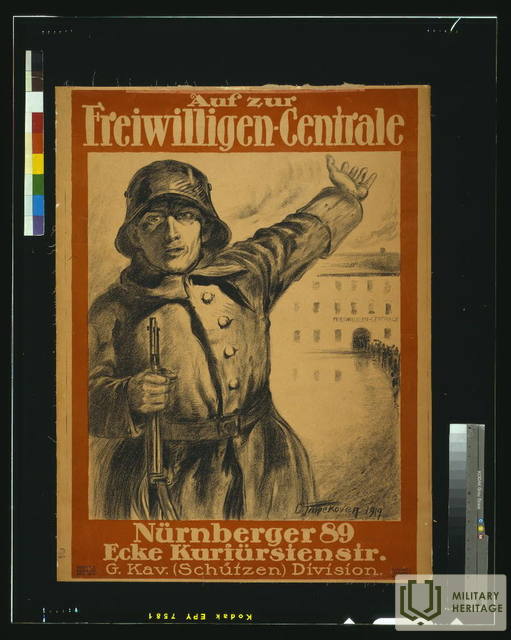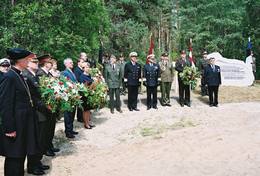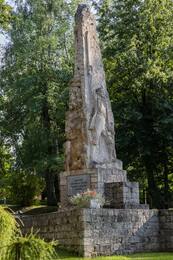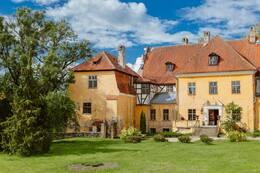German Iron Brigade
I World War I, I Wars of Independence
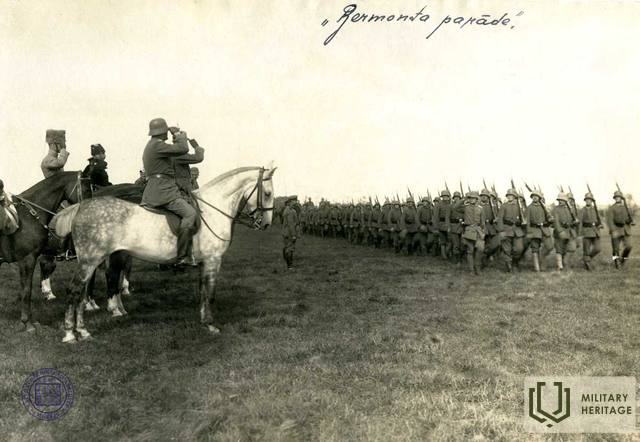
On November 29, 1918, the plenipotentiary of the Weimar Republic, August Vinnig, and the Central Council of German Soldiers forced the command of the German 8th Army to give permission to form a volunteer brigade for defense against the Red Army's 7th Army and the Western Army, which on November 25 launched an attack on the collapsing German army units, which retreated without significant resistance. By December 9, 1,500 German soldiers had volunteered for the brigade, out of an estimated 100,000-150,000 soldiers in the 8th Army.
On December 29, the Latvian Provisional Government concluded an Agreement on the Granting of Citizenship to Volunteers Fighting Against the Bolsheviks with Augustus Vinnig, on the admission of volunteers from Germany into the Latvian Landeswehr, committing to grant Latvian citizenship to German volunteers for at least 4 weeks of fighting against the Bolsheviks. Apparently, on the basis of this agreement, Rüdiger von der Golz had received permission from the German Minister of War Noske to recruit volunteer mercenaries from those in Germany, as well as from the soldiers of the 8th Army subject to demobilization.
Although many of the demobilized soldiers of the German army were tempted by the opportunities for profit and land in Latvia, many were more interested in the possibility of continuing the war and military adventures. During this time, numerous free corps units were formed in Germany and its occupied Eastern territories, which turned against the Social Democratic-led German Republic. A rapid influx of volunteers began in February. If von der Golz is to be believed, the total number of various German and Baltic German units reached 30-40,000 soldiers in the summer of 1919.[3] By April 1919, approximately 6,000 German volunteers had been gathered in Courland.
The Iron Brigade carried out its tasks, covering the retreat of the army from Vidzeme to Courland. On 17.01.1919. when the unit was taken over by its new commander Bišofs in Vaiņode, it had 284 bayonets and 22 swords. The personnel was constantly replenished and grew from a few hundred men in November and December 1918 to 4,000 men (of whom 1,714 were in combat formation), 10 cannons, 89 machine guns and one aircraft at the end of February 1919. When the VIII Army left the Baltics, it was subordinated to the command of the VI Reserve Corps (Golcs). At the beginning of March, it participated in the Latvian Land Guard attack on the LSPR army in the Skrunda-Saldus direction (the left wing of the Iron Brigade, next to which was the Landeswehr Kalpak battalion) to the Mažeiķi-Laižuva direction (the right wing).
On March 10, the Goldfeld squadron left the division, transferring to the service of the Provisional Government of Latvia. 22.05. Units of the Iron Division carried out combat operations against the Bolsheviks along the Jelgava-Riga highway, then captured the Iron Bridge over the Daugava in Riga. After the capture of Riga, the Iron Brigade was deployed in Bolderāja and the Daugavgrīva fortress. Renamed the "Iron Division". In mid-June 1919, it consisted of 3 infantry regiments, with 3 battalions in the 1st and 2nd regiments, but only 2 battalions in the 3rd regiment, a total of 8 battalions. In addition to them, the division also included a small jaeger battalion and 3 light artillery divisions, 3 batteries in each division. Each battery had 4 guns. The battalions consisted of 3 riflemen and 1 machine gun company. Each regiment also had a small mortar company of 4 mortars. The division also included one cavalry regiment of 4 squadrons, 2 pioneer companies and the 437th aviator squadron. After the defeat in the Battle of Cēsis on 26 June 1919, the Iron Division passed under the command of the Latvian Provisional Government (A. Niedras' cabinet) - the division's personnel did not lose their German citizenship, and supplies and salaries remained at the disposal of the German army.
More information sources
https://vesture.eu/Dzelzsdiv%C4%ABzija
https://lv.wikipedia.org/wiki/Dzelzsdiv%C4%ABzija#Dzelzsbrig%C4%81de
Related timeline
Related objects
Memorial stone to the Latvian and Estonian soldiers who fell in the Battle of Cēsis near Rauna
Located in Priekuļi parish, on the side of the Cēsis–Valmiera highway, near the bridge over the Rauna River.
A memorial stone with a granite memorial sign made by stonemason Voldemārs Koltovs to the soldiers who fell in the Battle of Cēsis can be viewed.
Opened in 2004, when the 85th anniversary of the Battle of Cēsis was celebrated.
A memorial stone to the 110 Estonian and 44 Latvian soldiers who fell in battle on the banks of the Rauna and Gauja rivers.
In the battles near Rauna and Gauja, the 6th Regiment of the 3rd Estonian Division (commander K.Tallo), the 3rd Regiment (commander J.Krūss) and the 2nd Cēsis Regiment of the North Latvian Brigade (commander K.Berķis) fought heroically.
Monument commemorating the Cēsis battles
The monument to the Estonian and Latvian soldiers who died in the Battles of Cēsis is located in Priekuļi municipality, Liepā, about 1 kilometre south of the Lode Railway Station, on the side of Rūpnīcas street. The first stone of the monument was laid on 22 September 1929, and the monument was unveiled on 11 August 1935. Based on a sketch by Sculptor Augusts Julla who lived in Jullas, Liepa parish, and made of limestone from the village of Allaži, the monument is a high-relief depiction of a peasant soldier leaning on a plough with one hand and a raised sword in the other. The death mask of the sculptor’s father Jānis Julla was used to create the face of the sculpture. According to Aivars Vilnis, a researcher of the history of Liepa parish, a bird’s eye view of the monument reveals that the base of and the path and stairs leading to the monument form the shape of an arrow facing Liepa Manor (Lindenhoff) in the direction of German positions during the Battles of Cēsis. There is doubt, of course, as to whether this was truly the author’s intention at the time; however, it certainly enriches our interpretation of the monument today. Next to the monument are the only natural sandstone arches in Latvia known as ‘Lielā Ellīte’ (‘Liepas Ellīte’ or the Devil’s Kiln).
The first monument in memory of the Battle of Cēsis and the fallen Estonian soldiers
Located next to the Veselava cemetery chapel.
The first monument to commemorate the Battle of Cēsis and the fallen Estonian soldiers was unveiled on August 5, 1923.
Its opening was attended by the first President of the Republic of Latvia, Jānis Čakste, and the Estonian Ambassador to Latvia, Jūlijs Saljemā.
The cemetery contains the remains of 16 Estonian soldiers who fell in the battles of Cēsis with the Baltic Landeswehr and the Iron Division in June 1919. Four of them were later reburied in their homeland. The monument was built with donations collected from local residents. It was designed by craftsman Dāvis Gruzde, after the owner of the Ķikuri house, Kārlis Bierņš.
Lielstraupe Castle
The Lielstraupe Castle is located in the centre of the town of Straupe. The castle is open to visitors and offers a journey through the centuries along with an orienteering exercise in the labyrinths of the castle. During the Battles of Cēsis, the Lielstraupe Castle housed the command post of Paul Ludwig Ewald von Kleist’s Battle Group of the Iron Division (German: Eiserne Division). During the battles, the castle was visited by Major Josef Bischoff, Captain Heinz Guderian and others. The castle was used for the coordination of an attack in the direction of Stalbe on 21-22 June. The Iron Division was a military force of German mercenaries during the Latvian War of Independence, which was formed from soldiers of the 8th Army of the demobilised German Empire and volunteer mercenaries. It was the best-known part of the German Free Corps and among the best trained and most combat-ready military forces in the Baltics in 1919. During the Soviet period, from 1949 to 1959, the administration of the Lielstraupe Machine-tractor Station operated out of Manor Castle. During this time, the castle was also equipped with training rooms and dormitories for tractor drivers, while the former stable of the manor housed workshops. From 1963 to 2018, the castle was managed by medical institutions, and it was said of the Straupe Narcological Hospital in Latvia that it ‘even treats the walls’.
Related stories
About the national patriot First Lieutenant Vili Gelbi
The fate of Lieutenant Colonel Vilis Gelbe (1890-1919) reflects the difficult situation in the formation of our state and army, as well as the assessment of these events.
With the proclamation of the Latvian state on November 18, 1918, the Latvian War of Independence and the work of building the armed forces began. In the first ranks of the Latvian volunteer soldiers was the naval lieutenant Vilis Gelbe, who was born in Courland.
The beginning, course and conclusion of the Battle of Cēsis
The victory in the Battle of Cēsis was destined to become a turning point in the Latvian and Estonian struggle for the independence of their country. This victory put an end to the plans of the Andrievs Niedra government and the German general Rüdiger von der Goltz to conquer the Baltics. Instead, the Latvian Provisional Government of Kārlis Ulmanis resumed its activities in Liepāja.
Aizporis Manor during the War of Independence
Aizporu Half Manor, Aizpute district, Kalvene municipality, is the westernmost place in Latvia to which Colonel Oskars Kalpaks' separate battalion retreated.
Halfway between Rudbārži and Kalvenė, on the side of the road, is the Aizpore cemetery. There is a monument and 12 memorials to the volunteer soldiers of Oskars Kalpaka's battalion.




